M14 rifle
The M14 rifle, officially the United States Rifle, Caliber 7.62 mm, M14, is an American select-fire battle rifle that fires 7.62×51mm NATO (.308 in) ammunition. It became the standard-issue rifle for the U.S. military in 1959 replacing the M1 Garand rifle in the U.S. Army by 1958 and the U.S. Marine Corps by 1965 until being replaced by the M16 rifle beginning in 1968. The M14 was used by U.S. Army, Navy, and Marine Corps for basic and advanced individual training (AIT) from the mid-1960s to the early 1970s.[5][7]
| U.S. rifle, caliber 7.62 mm, M14 | |
|---|---|
_(7414626342).jpg.webp) An M14 rifle shown with a 20-round magazine | |
| Type | Battle rifle, automatic rifle, sniper rifle, semi-automatic rifle |
| Place of origin | United States |
| Service history | |
| In service | 1959–present 1959–1964 (as the standard U.S. service rifle) |
| Used by | See Users |
| Wars | See Conflicts |
| Production history | |
| Designed | 1954 |
| Manufacturer | Springfield Armory Winchester Harrington & Richardson Thompson-Ramo-Wooldridge, Inc. |
| Produced | 1959–1980[1][2] |
| No. built | 1.3 million[3] |
| Variants | M14E1, M14E2/M14A1, M14K, M21, M25, Mk 14 EBR, M1A rifle |
| Specifications | |
| Mass | 9.2 lb (4.1 kg) empty 10.7 lb (4.85 kg) w/ loaded magazine |
| Length | 44.3 in (1,126 mm) |
| Barrel length | 22 in (559 mm) |
| Cartridge | 7.62×51mm NATO (.308 in) |
| Action | Gas-operated, rotating bolt |
| Rate of fire | 700–750 rounds/min |
| Muzzle velocity | 850 m/s (2,800 ft/s) |
| Effective firing range | 460 m (500 yd)[4] 800+ m (875+ yd) (with optics)/3,725 maximum range[5][6] |
| Feed system | 20-round detachable box magazine |
| Sights | Aperture rear sight, "barleycorn" front sight |
The M14 was the last American battle rifle issued in quantity to U.S. military personnel. It was replaced by the M16 assault rifle, a lighter weapon using a smaller caliber intermediate cartridge. The M14 rifle remains in limited service in all branches of the U.S. military, with variants used as sniper and designated marksman rifles, accurizing competition weapons, and ceremonial weapons by honor guards, color guards, drill teams and ceremonial guards. Civilian semi-automatic models are used for hunting, plinking, target shooting, and shooting competitions.[5]
The M14 is the basis for the M21[8] and M25 sniper rifles which were largely replaced by the M24 Sniper Weapon System.[9] A new variant of the M14, the Mk 14 Enhanced Battle Rifle (EBR), has been in service since 2002.[10]
History
Early development
The M14 was developed from a long line of experimental weapons based upon the M1 Garand rifle. Although the M1 was among the most advanced infantry rifles of the late 1930s, it was not an ideal weapon. Modifications were already beginning to be made to the basic M1 rifle's design during the last months of World War II. Changes included adding fully automatic firing capability and replacing the eight-round en bloc clips with a detachable box magazine holding 20 rounds. Winchester, Remington, and Springfield Armory's own John Garand offered different conversions. Garand's design, the T20, was the most popular, and T20 prototypes served as the basis for a number of Springfield test rifles from 1945 through the early 1950s.[11]

In 1945, Earle Harvey of Springfield Armory designed a completely different rifle, the T25, for the new T65 .30 light rifle cartridge [7.62×49mm] at the direction of Col. Rene Studler, then serving in the Pentagon.[12] The two men were transferred to Springfield Armory in late 1945, where work on the T25 continued.[12] The T25 was designed to use the T65 service cartridge, a Frankford Arsenal design based upon .30-06 cartridge case used in the M1 service rifle, but shortened to the length of the .300 Savage case.[12] Although shorter than the .30-06, with less powder capacity, the T65 cartridge retained the ballistics and energy of the .30-06 due to the use of a recently developed ball powder made by Olin Industries.[12][13] After experimenting with several bullet designs, the T65 was finalized for adoption as the 7.62×51mm NATO cartridge.[12] Olin Industries later introduced the cartridge on the commercial market as the .308 Winchester.[12] After a series of revisions by Earle Harvey and other members of the .30 light rifle design group following the 1950 Fort Benning tests, the T25 was renamed the T47.[12]
The T44 prototype service rifle was not principally designed by any single engineer at Springfield Armory, but was a conventional design developed on a shoestring budget as an alternative to the T47.[12] With minimal funding available, the earliest T44 prototypes used T20E2 receivers fitted with magazine filler blocks and re-barreled for 7.62×51mm NATO, with the long operating rod/piston of the M1 replaced by the T47's gas cut-off system.[12] Lloyd Corbett, an engineer in Harvey's rifle design group, added various refinements to the T44 design, including a straight operating rod and a bolt roller to reduce friction.[12]
Infantry Board service rifle trials

The T44 participated in a competitive service rifle competition conducted by the Infantry Board at Fort Benning, Georgia against the Springfield T47 (a modified T25) and the T48, a variant of Fabrique Nationale's FN FAL (from "Fusil Automatique Leger", French for "light automatic rifle").[14] The T47, which did not have a bolt roller and performed worse in dust and cold weather tests than both the T44 and the T48, was dropped from consideration in 1953.[12] During 1952–53, testing proved the T48 and the T44 roughly comparable in performance, with the T48 holding an advantage in ease of field stripping and dust resistance, as well as a longer product development lead time.[12][14] A Newsweek article in July 1953 hinted that the T48/FAL might be selected over the T44.[12][15] During the winter of 1953–54, both rifles competed in the winter rifle trials at U.S. Army facilities in the Arctic.[14][16] Springfield Armory engineers, anxious to ensure the selection of the T44, had been specially preparing and modifying the test T44 rifles for weeks with the aid of the armory's cold chamber, including redesign of the T44 gas regulator and custom modifications to magazines and other parts to reduce friction and seizing in extreme cold.[14][16] The T48 rifles received no such special preparation, and in the continued cold weather testing began to experience sluggish gas system functioning, aggravated by the T48's close-fitting surfaces between bolt and carrier, and carrier and receiver.[12][14][16] FN engineers opened the gas ports in an attempt to improve functioning, but this caused early/violent extraction and broken parts as a result of the increased pressures.[12][14][16] As a result, the T44 was ranked superior in cold weather operation to the T48.[14] The Arctic Test Board report made it clear that the T48 needed improvement and that the U.S. would not adopt the T48 until it had successfully completed another round of Arctic tests the following winter.[12][14]
In June 1954, funding became available to manufacture newly fabricated T44 receivers specially designed for the shorter T65 cartridge.[12] This one change to the T44 design saved a pound in rifle weight over that of the M1 Garand.[12] Tests at Fort Benning with the T44 and T48 continued through the summer and fall of 1956.[12] By this time, the T48/FAL rifles had been so improved that malfunction rates were almost as low as the T44.[12]
The T44 was selected over the T48/FAL primarily due to weight (T44 was a pound lighter), simplicity with fewer parts, the T44's self-compensating gas system, and the argument that the T44 could be manufactured on existing machinery built for the M1 rifle (this later turned out to be unworkable).[12][14][16][17] In 1957, the U.S. formally adopted the T44 as the U.S. infantry service rifle, designated M14.[12]
Production contracts
Initial production contracts for the M14 were awarded to the Springfield Armory, Winchester, and Harrington & Richardson.[18] Thompson-Ramo-Wooldridge Inc. (TRW) would later be awarded a production contract for the rifle as well. 1,376,031 M14 service rifles were produced from 1959 to 1964.[19]
National Match M14
Springfield Armory produced 6,641 new M14 NM rifles in 1962 and 1963, while TRW produced 4,874 new M14 NM rifles in 1964. Springfield Armory later upgraded 2,094 M14 rifles in 1965 and 2,395 M14 rifles in 1966 to National Match specifications, while 2,462 M14 rifles were rebuilt to National Match standards in 1967 at the Rock Island Arsenal. A total of 11,130 National Match rifles were delivered by Springfield Armory, Rock Island Arsenal, and TRW during 1962–1967.[19]
Production M14 rifles made by Springfield Armory and Winchester used forged receivers and bolts milled from AISI 8620 steel, a low-carbon molybdenum-chromium steel. Harrington & Richardson M14 production used AISI 8620 steel as well, except for ten receivers milled from AISI 1330 low-carbon steel and a single receiver made from alloy steel with a high nickel content.[19]
Deployment



After the M14's adoption, Springfield Armory began tooling a new production line in 1958, delivering the first service rifles to the U.S. Army in July 1959. However, long production delays resulted in the 101st Airborne Division being the only unit in the army fully equipped with the M14 by the end of 1960. The Fleet Marine Force finally completed the change from M1 to M14 in late 1961. Springfield Armory records reflect that M14 manufacture ended as TRW, fulfilling its second contract, delivered its final production increment in fiscal year 1965 (1 July 1964 – 30 June 1965). The Springfield archive also indicates the 1.38 million rifles were acquired for just over $143 million, for a unit cost of about $104.[1][2]
The rifle served adequately during its brief tour of duty in Vietnam.[20] Though it was unwieldy in the thick brush due to its length and weight, the power of the 7.62×51mm NATO cartridge allowed it to penetrate cover quite well and reach out to extended range, developing 2,560 ft·lbf (3,463 J) of muzzle energy. However, there were several drawbacks to the M14. The traditional wood stock of the rifle had a tendency to swell and expand in the heavy moisture of the jungle, adversely affecting accuracy. Fiberglass stocks were produced to resolve this problem, but the rifle was discontinued before very many could be distributed for field use. Also, because of the M14's powerful 7.62×51mm cartridge, the weapon was deemed virtually uncontrollable in fully automatic mode, so most M14s were permanently set to semi-automatic fire only to avoid wasting ammunition in combat.[18][13][21]
The M14 was developed to replace seven different weapons—the M1 Garand, M1903 Springfield, M1917 Enfield, M1 carbine, M3 submachine gun, M1928/M1 Thompson, and M1918 Browning automatic rifle (BAR). The intention was to simplify the logistical requirements of the troops by limiting the types of ammunition and parts needed to be supplied. However, it proved to be an impossible task to replace all these weapons. The M14 was also deemed "completely inferior" to the World War II M1 Garand in a September 1962 report by the U.S. Department of Defense comptroller.[22] The cartridge was too powerful for the submachine gun role and the weapon was simply too light to serve as a light machine gun replacement for the BAR.[23]
Replacement
The M14 remained the primary infantry rifle in Vietnam until it was replaced by the M16 in 1967, though combat engineer units kept them several years longer. Further procurement of the M14 was abruptly halted in early 1968 due to the U.S. Department of Defense report which had also stated that the AR-15 (soon to be M16) was superior to the M14. (The DOD did not cancel FY 1963 orders to be delivered.) After the report, a series of tests and reports by the U.S. Department of the Army followed that resulted in the decision to cancel the M14.[22] The M16 was ordered as a replacement for the M14 by direction of Secretary of Defense Robert McNamara in 1964, over the objection of the U.S. Army officers who had backed the M14. (Other factions within the Army research and development community had opposed the M14 and the 7.62×51mm round from the start.) Though production of the M14 was officially discontinued, some disgruntled troops managed to hang on to them while deriding the early model M16 as a frail and under-powered "Mattel toy" that was prone to jam,[24][25] though these characteristics were later discovered by a Congressional investigation to be the result of intentional attempts by Army bureaucracy to sabotage the M16's field performance in Vietnam, at the cost of American lives.[26] In late 1967, the U.S. Army designated the M16 as the "Standard A" rifle, and the M14 became a "Limited Standard" weapon. The M14 rifle remained the standard rifle for U.S. Army Basic Training and troops stationed in Europe until 1970.[27]
The U.S. Army converted several thousand M14s into M21 sniper rifles, which remained standard issue for this purpose until the adoption of the M24 SWS in 1988.
In 1969, tooling for the M14 was sold to Taiwan and later many rifles were exported to Baltic countries and Israel.[28][29]
Post-1970 U.S. military service
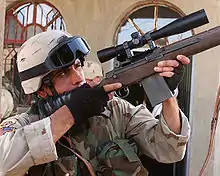
In the mid-1990s, the Marine Corps chose a new rifle for Designated Marksman use, an M14 modified by the Precision Weapons Shop in Marine Corps Base Quantico called the Designated Marksman Rifle (DMR). It is intended for use by security teams (SRTs, FAST companies), and Marine Scout Snipers in the cases where a semi-automatic rifle would be more appropriate than the standard bolt-action M40A1/A3 rifle. The USMC Rifle Team uses the M14 in shooting competitions. Although the M14 was phased out as the standard-issue rifle by 1970, M14 variants are still used by various branches of the U.S. Military as well as other armed forces, especially as a sniper rifle and as a designated marksman rifle, due to its accuracy and effectiveness at long range. Few M14s were in use in the Army until the Afghanistan and Iraq Wars. Since the start of these conflicts, many M14s have been employed as designated marksman and sniper rifles. These are not M21 rifles, but original production M14s. Common modifications include scopes, fiberglass stocks, and other accessories.[30] A 2009 study conducted by the U.S. Army claimed that half of the engagements in Afghanistan occurred from beyond 300 meters (330 yd).[31] America's 5.56×45mm NATO service rifles are ineffective at these ranges; this has prompted the reissue of thousands of M14s.[32]

.jpg.webp)
The 1st Battalion of the 3rd United States Infantry Regiment ("The Old Guard") in the Military District of Washington is the sole remaining regular U.S. Army combat field unit where the M14 is still issued as the standard rifle, along with a chromed bayonet and an extra wooden stock with white sling for military funerals, parades, and other ceremonies. The United States Air Force Honor Guard uses a version of the M14.[33] The U.S. Navy Ceremonial Guard and Base Honor Guards also use the M14 for 3-volley salutes in military funerals. It is also the drill and parade rifle of the United States Military Academy, United States Naval Academy, United States Air Force Academy, The Citadel, Norwich University, Virginia Military Institute, and North Georgia College and State University.[34] U.S. Navy ships carry several M14s in their armories. They are issued to sailors going on watch out on deck in port, and to Backup Alert Forces. The M14 is also used to shoot a large rubber projectile to another ship when underway to start the lines over for alongside refueling and replenishment.[35]

Various sniper variants have been used by the United States Navy SEALs. Often mistaken for the M21 in the overt literature, only one of them has received a standard name in the U.S. military designations system: the M25, developed by the Special Forces. SEALs also use the Mk 14 Mod 0 Enhanced Battle Rifle (EBR) for close-quarters battle and in a designated marksman role. "Delta Force" units are known to have used M14 sniper variants. According to Black Hawk Down: A Story of Modern War, the well-known account of the Battle of Mogadishu, Sergeant First Class Randy Shughart used an M14 for sniping from helicopters to provide support fire to ground troops.[36]
The U.S. Army Special Forces ("Green Berets") have made some use of the M25 "spotter rifle". The M25 was developed in the late 1980s within the 10th Special Forces Group, which was charged to support Special Forces sniper weapons as well as the Special Operations Target Interdiction Course (SOTIC). The M25 was first planned as a replacement for the old M21, but after the Army adoption of the M24 SWS as its standard sniper rifle, the M25 was intended to be used by spotters of the sniper teams, while the snipers would use the bolt-action M24.
The M14 has remained in service longer than any other U.S. infantry rifle, surpassing the Springfield M1903 rifle. It also holds the distinction of serving as the standard infantry rifle of the U.S. Army for the second-shortest span of time of any service rifle, only surpassed by the short-lived US Krag–Jørgensen rifles and carbines.[37]
Service with other nations
The Philippines issues M14 rifles, M1/M2 carbines, M1 rifles, and M16 rifles, to their civilian defense forces and various cadet corps service academies. The Hellenic Navy uses the M14.
The M14 production Springfield tooling and assembly line was sold in 1967 to the Republic of China (Taiwan), who in 1968 began producing their Type 57 Rifle. The State Arsenal of the Republic of China produced over 1 million of these rifles from 1969 to the present. Other than the surface finish it is essentially a US rifle. It is used by the reserves and as a backup defense weapon and used by airport guards.
In Mainland China, Norinco has produced an M14 variant for export, being sold in the U.S. prior to the importation ban of 1989 and the enactment of the Violent Crime Control and Law Enforcement Act of 1994. Rifles made by Poly Technologies were imported to the US in the 1980s but were banned from further import in 1989 by the George H.W. Bush Administration.[38] They were being sold in Canada, Italy and New Zealand as of 2008.[39] They have been marketed under the M14S[40] and M305 names.[41]
Rifle design
Receiver markings
Stamped into receiver heel:
- U.S. Rifle
- 7.62-MM M14
- Springfield Armory (or commercial contractor name)
- Serial number
Stock

The M14 rifle was first furnished with a walnut stock, then with birch and finally with a synthetic (fiberglass) stock, which was adopted for use in damp jungle environments in Vietnam, since the wood versions would often become warped and swollen with moisture. The stock was also fitted with a hinged shoulder rest for improved user comfort when firing from a prone position.[5] Original equipment walnut and birch stocks carry the Department of Defense acceptance stamp or cartouche (an arc of three stars above a spread-winged eagle). These stocks also carried a proof stamp, a P within a circle, applied after successful test-firing.
Rifles manufactured through late 1960 were provided with walnut handguards. Thereafter synthetic, slotted (ventilated) hand guards were furnished but proved too fragile for military use. These were replaced by the solid synthetic part still in use, usually in dark brown, black or a camouflage pattern.
Rifling
Standard M14 rifling has right-hand twist in 1:12 inches with 4 grooves.
Accessories
Although M14 rifle production ended in 1964, the limited standard status of the weapon resulted in the continued manufacture of accessories and spare parts into the late 1960s and beyond.
- M6 bayonet with M8A1 sheath
- M2 Bandoleer (Has 6 pockets, each containing 2 × 5-round Mauser-type clips for a total of 60 rounds, and a pouch for a magazine filler. The sling was adjustable and was held in place with a matte-black steel safety pin). Standard Operating Procedure was for the operator to use up the ammunition in the bandoleers before using the loaded magazines in the ammo pouches. The pockets' stitching could be ripped out to allow the bandoleer to carry 6 pre-loaded 20-round magazines.
- Sling [The service rifle used a one-piece cotton or nylon webbing sling and the competition and sniping variants use the standard M1907 two-piece leather sling]
- Cleaning kit (contained in the stock's butt-trap) included: a combination tool, ratchet chamber brush, plastic lubricant case, brass bore brush, four cleaning rod sections, cleaning rod case, and a cleaning rod patch-holding tip.
- M5 winter trigger and winter safety
- M12 blank firing attachment and M3 breech shield
- Cartridge charger clip (holds five cartridges)
- Magazine filler (or "spoon") for charging detached magazines externally. (The M14 has a groove over the action that allows the operator to place a loaded clip and top off the attached magazine internally through the open action).
- M1956 Universal Small Arms Ammunition Pouch, First Pattern (could hold 2 × 20-round M14 magazines horizontally).
- M1956 Universal Small Arms Ammunition Pouch, Second Pattern (could hold 3 × 20-round M14 magazines vertically).
- M1961 ammunition magazine pouch. (Could carry 1 × 20-round M14 magazine. The bottom of the pouch contained eyelets for attaching a First Aid Pouch or 3-cell (6 pocket) Grenade Carrier that could tie down around the thigh.)
- M2 bipod
- M76 rifle grenade launcher
- M15 grenade launcher sight
- Mk 87 Mod 0/1 line (rope) throwing kit
Types of sights
- Rear peep, front blade, metric
- Rear National Match peep with hood, front National Match blade, metric
Variants and related designs

M15
The M15 Squad Automatic Weapon was a modified M14 developed as a replacement for the .30-06 M1918 Browning Automatic Rifle for use as a squad automatic weapon. It added a heavier barrel and stock, two pistol grips (one fixed, one folding) a hinged buttplate, a selector switch for fully automatic fire, and a bipod. The sling was from the BAR. Like the M14, it was chambered for 7.62×51mm NATO.
Firing tests showed that the M14, when equipped with the selector switch, hinged buttplate and bipod, performed as well as the M15. As a result, the M15 was dropped and the modified M14 became the squad automatic weapon. Accuracy and control problems with this variant led to the addition of a pistol grip, a folding rubber covered metal foregrip and a muzzle stabilizer. However, it was a poor suppressive fire weapon owing to 20-round magazines and it overheated rapidly.
M14E1
The M14E1 was tested with a variety of folding stocks to provide better maneuverability for armored infantry, paratroopers and others. No variant was standardized.
M14E2/M14A1
Selective fire version of the standard M14 used as a squad automatic weapon. Successor to the full-automatic M14 with a bipod and the never issued M15. The developmental model was known as the M14E2. As a conceptional weapon developed by the Infantry School, it was known as the M14 (USAIB) (United States Army Infantry Board). It was issued in 1963 and redesignated as M14A1 in 1966.
It had a full pistol-gripped in-line stock to control recoil, a plastic upper forend to save weight, a muzzle compensator, the BAR sling, an M2 bipod, and a folding metal vertical foregrip mounted under the forend of the stock. Although an improvement over the M14 when in full-auto, it was still difficult to control, overheated rapidly, and the 20-round magazine limited its ability to deliver suppressive fire.
M14M (Modified)/M14NM (National Match)
The M14M is a semi-automatic only version of the standard M14 that was developed for use in civilian rifle marksmanship activities such as the Civilian Marksmanship Program. M14M rifles were converted from existing M14 rifles by welding the select-fire mechanism to prevent full-automatic firing. The M14NM (National Match) is an M14M rifle built to National Match accuracy standards.
The M14M and M14NM rifles are described in a (now-obsolete) Army regulation, AR 920-25, "Rifles, M14M and M14NM, For Civilian Marksmanship Use," dated 8 February 1965. Paragraph 2, among other things, stated that the Director of the Alcohol and Tobacco Tax Division, Internal Revenue Service, Department of the Treasury (predecessor to the Bureau of Alcohol, Tobacco, Firearms, and Explosives) had ruled that M14M and M14NM rifles so modified would not be subject to the 1934 National Firearms Act (NFA) and, as such, could be sold or issued to civilians. However, with the passage of the Gun Control Act of 1968, the NFA was amended to prohibit sales of previously modified automatic weapons such as the M14M and M14NM to civilians.
M14 SMUD
Stand-off Munition Disruption, used by Explosive Ordnance Disposal personnel to destroy unexploded ordnance. Essentially an M14 National Match rifle with scope.
Mk 14 EBR
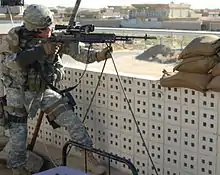
The Mk 14 Enhanced Battle Rifle is a more tactical version of the M14, with a shorter 18-inch barrel, a retractable stock and multiple rails for more accessories.
M14 Tactical
Modified M14 using the same stock as the Mk 14 but with a 22-inch barrel and a Smith Enterprise muzzle brake, used by the U.S. Coast Guard.
M14 Designated Marksman Rifle
Designated marksman version of the M14, used by the U.S. Marine Corps. Replaced by the M39 Enhanced Marksman Rifle.
M39 Enhanced Marksman Rifle
Modified M14 DMR fitted with the same stock as Mk 14, used by the U.S. Marine Corps. Being replaced by the M110 Semi-Automatic Sniper System.[42]
M89SR Model 89 Sniper Rifle
The M89SR is an M14 in bullpup configuration first introduced by Sardius in the 1980s. Later produced by Technical Equipment International (TEI) for the Israel Defense Forces
AWC G2A Sniper Rifle
AWC G2A Sniper Rifle is a modified M14 with bullpup stock designed by Lynn McWilliams and Gale McMillian in the late 1990s. Produced and delivered for testing at the Fort Bragg sniper school.
M21, M25 sniper rifles
The M21 and M25 are accurized sniper rifle versions, built to closer tolerances than the standard M14. These are the more standard sniper rifle variants of the M14.
Commercial production

Armscorp M14
From 1987 to 1994, Armscorp of America or Armscorp USA produced investment-cast semi-auto M14 receivers. During the first year of production, Armscorp receivers were supplied by Smith Manufacturing of Holland, Ohio, which were heat treated and finish machined by Armscorp. From 1988 to 1994, a few receivers with an 'S' serial number prefix were made of stainless steel. From approximately 1994 until 2008, Armscorps receiver castings were supplied by the Lamothermic Corporation of Brewster, New York.
CAR 14
A product of Troy Industries the CAR 14 (Carbine Assault Rifle 14) is a smaller and lighter tactical version of the M14. Its barrel is 12.5 inches long and it weighs 7.9 pounds. The rifle has select fire ability, a threaded flash suppressor for a suppressor, a tactical rail on top for sights and other attachments, and the operating rod cover.[43]
Federal Ordnance
From 1984 to 1991, Federal Ordnance of South El Monte, California sold a semi-auto version of the M14 rifle. Initially named the M14 or M14A, the rifle utilized an aftermarket semi-auto receiver fitted with surplus USGI M14 parts. All receivers were machined from castings of AISI 8620 alloy steel. Except for the first fifty receivers, the castings were supplied by Electro Crisol Metal, S.A. of Santander, Spain, then imported to the US for heat treatment, finish machining, and exterior phosphate treatment. M14 and M14A receivers were heat-treated using the carburizing process by a firm in Santa Ana, California, followed by finish machining on a CNC machine at Federal Ordnance in South El Monte.
Federal Ordnance M14 and M14A receivers were heat-treated and carburized according to USGI M14 requirements. Each completed production rifle was proof fired, then tested for functioning by firing three rounds. USGI parts and bolts were used extensively in Federal Ordnance rifles through at least serial number 88XX. In 1989, Federal Ordnance renamed the rifle the M14SA and M14CSA. Rifles in the 93XX serial range and higher have modified receivers designed to accept Chinese-made bolts, barrels, and other parts owing to a shortage of original USGI components. Approximately 51,000 complete Federal Ordnance M14 rifles and 60,000 or more receivers were manufactured before production was halted in late 1991.[18]
La France Specialties M14K
The M14K is a commercial version of the M14 designed and built by Timothy F. LaFrance of La France Specialties of San Diego, California, most using forged receivers produced by Smith Enterprise of Tempe, Arizona. This rifle has a custom-made short barrel with a custom-made flash suppressor, shortened operating rod, and employs a unique gas tube system. Fully automatic versions have a removable flash suppressor. Semi-automatic versions (of which very few were made) have a silver-brazed flash hider to comply with the requirement that Title I firearms have a 16" barrel. Most M14Ks employ the M60 gas tube system. Some late-model M14Ks employ a custom-designed and manufactured gas system. Both are intended to control the rate of fire in fully automatic mode. The rear sight is a custom-made National Match type aperture, and the front sight is a custom-made narrow blade, wing-protected sight to take advantage of the additional accuracy afforded by the special barrel.
The stocks and handguards on M14Ks are shortened versions of the GI birch or walnut stock, but make use of the original front ferrule. The front sling mount is relocated slightly to rear, to accommodate the shortened stock. Most handguards are of the solid, fiberglass variety (albeit shortened), but a limited number were made with shortened wood handguards. The steel buttplate was deleted in favor of a rubber recoil pad, which greatly reduces perceived recoil. A limited number of M14Ks were manufactured with the BM-59 Alpine / Para folding stock. These too had the shortened stocks and handguards, making for an extremely compact package especially suited to vehicular and airborne operations. A couple of M14Ks were built for SEAL Team members using the tubular folding stock assembly on a cut-down M14E2 stock found on some of the Team's full-size M14s prior to adoption of the Sage International EBR stock for M14 applications. These are by far one of the rarest variants of the M14K.
Norinco

The Chinese firm Norinco manufactures versions of the M14 rifle known as the M14S (Sporter)[40][18] and the M305.[41] There are two versions of the M305. The M305A/B, one with the same barrel as the regular M14 and one with a short barrel.[44][45] The M305A is an M14 chambered to fire 7.62x39 ammo.[46] and the M305B is a M14 with an 18.5" barrel and chambered to fire in 7.62 NATO caliber.[47] Copies of the select-fire and semi-auto versions of the M14 were also made by Norinco.[18]
These rifles have been banned from importation (1989 for all Polytech rifles) and (1994 for Norinco rifles) to the U.S., due to a Clinton era prohibition on Chinese made firearms. They were commonly sold and were popular in Canada for hunting and target shooting until they were reclassified as Prohibited firearms on May 1, 2020.[48]
Production of these M14s were contracted out to Yunnan Xiyi Industry Company Limited or State Factory Number 356 from the rifles to the 7.62 NATO magazines.[49][50]
Polytech Industries
Polytech Industries of China made an unlicensed version of the M14 rifle known as the M14S. Polytechs, unlike Norinco rifles, were all banned in the 1989 firearm importation ban by the President George HW Bush administration.[51]
Smith Enterprise, Inc
Smith Enterprise Inc. was founded as Western Ordnance in 1979 by Richard Smith in Mesa, Arizona and the company made numerous types of rifles, but specialized in the M1 Garand and M14.[52] In 1993, Western Ordnance reformed as Smith Enterprise and has built and rebuilt numerous M14 rifles for the US Military and the militaries of Colombia, Canada and other nations.[53][54]
The U.S. Department of Defense has contracted Smith Enterprise to build and modify M14 rifles for use by soldiers, Marines and sailors in Iraq and Afghanistan.[55] Smith Enterprise played a major part in the M14 rifle modernization projects for various US military units which resulted in the development of the U.S. Navy Mark 14 Enhanced Battle Rifle (EBR).[53][56][57] The company's history included originally making forged receivers for M14 rifles and briefly switching to investment casting.[52] Smith stopped making receivers for a few years, but reentered the market with receivers machined from bar stock in 2002.[53]
In 2003 Smith Enterprise Inc. created its version of the M14 Enhanced Battle Rifle known as the MK14 Mod 0, type SEI. The rifle used a medium heavy weight 18.0" barrel and was used as a basis to create the US Navy's Mark 14 Mod 0 with Springfield Armory, Inc. being tasked to supply the necessary machinery in cooperation with the Naval Surface Warfare Center Crane Division.[53] SEI builds an improved M14 gas cylinder as a component of their specialized rifles and a part for the military to upgrade older rifles. The gas cylinder is assigned the NATO Stock Number: NSN 1005-00-790-8766.[58]
Springfield Armory
Springfield Armory, Inc. of Geneseo, Ill., produces a semi-automatic-only version of the M14 rifle. The standard rifle is known as the M1A. The company produces several variations of the basic rifle with different stocks, barrel weights, barrel lengths, and other optional features. The Springfield M1A and its model variants have been widely distributed in the U.S. civilian market and have seen use by various law enforcement agencies in the U.S. Springfield Armory, Inc. also produce the SOCOM series and the Scout Squad Rifle, based on the short-barreled version of the M14. The SOCOM 16 comes with provisions to mount a red dot sight and the SOCOM II adds railed handguards to the package. Springfield Armory's M21 tactical is a civilian version of the M21 Sniper Weapon System currently in use by the U.S. military.[59]
Gallery
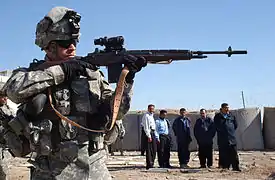 A U.S. soldier demonstrates shooting an M14 rifle to Iraqi Highway Patrol (IHP) police officers during training in Iraq, 2006.
A U.S. soldier demonstrates shooting an M14 rifle to Iraqi Highway Patrol (IHP) police officers during training in Iraq, 2006.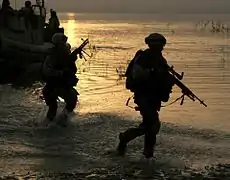 Members of the 13th Marine Expeditionary Unit, enter the reeds on the edge of Lake Tharthar in Iraq to conduct cordon and search operations July 15, 2007.
Members of the 13th Marine Expeditionary Unit, enter the reeds on the edge of Lake Tharthar in Iraq to conduct cordon and search operations July 15, 2007.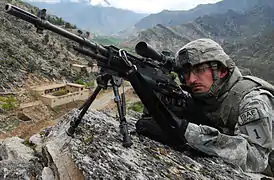 A U.S. soldier scans for activity during a combat patrol in Afghanistan, 2009.
A U.S. soldier scans for activity during a combat patrol in Afghanistan, 2009. A soldier with an M14 equipped with a Sage M14ALCS chassis stock.
A soldier with an M14 equipped with a Sage M14ALCS chassis stock. Two Sea-Air-Land (SEAL) team members, one equipped with an AN/PAQ-1 laser target designator, right, the other armed with an M14 rifle, assume a defensive position
Two Sea-Air-Land (SEAL) team members, one equipped with an AN/PAQ-1 laser target designator, right, the other armed with an M14 rifle, assume a defensive position Battle of Hamo Village During the Tet Offensive. US Marines and ARVN troops defend a position against enemy attack. Photo taken circa January 1968.
Battle of Hamo Village During the Tet Offensive. US Marines and ARVN troops defend a position against enemy attack. Photo taken circa January 1968. Soldiers in a Niger army unit stand in formation while a dignitary visits their outpost during Operation Desert Shield. The men are armed with M14 rifles.
Soldiers in a Niger army unit stand in formation while a dignitary visits their outpost during Operation Desert Shield. The men are armed with M14 rifles.
Conflicts
The M14 rifle has been used in the following conflicts:
Users
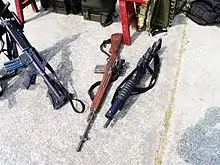
 Afghanistan: Used by soldiers of the Afghan National Army presidential guard for ceremonial duties.
Afghanistan: Used by soldiers of the Afghan National Army presidential guard for ceremonial duties. Argentina: Used by Argentine soldiers of C Company, Regimento (Especial) de Infanteria 25 in the Falklands War at the Battle of Goose Green and San Carlos.[18]
Argentina: Used by Argentine soldiers of C Company, Regimento (Especial) de Infanteria 25 in the Falklands War at the Battle of Goose Green and San Carlos.[18].svg.png.webp) Australia: Small quantities of XM21 sniper variants were issued by the Australian Army in the Vietnam War. M14 EBRs were also fielded by Australian special operations forces in Afghanistan.[63][64]
Australia: Small quantities of XM21 sniper variants were issued by the Australian Army in the Vietnam War. M14 EBRs were also fielded by Australian special operations forces in Afghanistan.[63][64] Central African Republic: Self-defence units[65]
Central African Republic: Self-defence units[65] Colombia[66]
Colombia[66] Costa Rica[66]
Costa Rica[66] Dominican Republic[66]
Dominican Republic[66] Ecuador[66]
Ecuador[66] El Salvador[66]
El Salvador[66] Eritrea[66]
Eritrea[66] Estonia: Adopted by Estonian military as marksman's rifle, modified by E-Arsenal called the Täpsuspüss M14-TP (Precision Rifle M14-PR), with heavy barrel, bipod, synthetic stock, and optical 4× sight.[67][68]
Estonia: Adopted by Estonian military as marksman's rifle, modified by E-Arsenal called the Täpsuspüss M14-TP (Precision Rifle M14-PR), with heavy barrel, bipod, synthetic stock, and optical 4× sight.[67][68] Ethiopia[66]
Ethiopia[66] Greece[69]
Greece[69] Haiti: Used by Haitian security forces in the 2004 Haitian coup d'état.[18]
Haiti: Used by Haitian security forces in the 2004 Haitian coup d'état.[18] Honduras[66]
Honduras[66] Iraq: Used by Iraqi special forces under Counter-Terrorism Service control.[70]
Iraq: Used by Iraqi special forces under Counter-Terrorism Service control.[70] Israel: Used as sniper rifle with eventual conversion and production as M89SR.[18][71] Israeli M14s were modified with full auto disabled and the buttstock modified to have a built-in cheek piece.[72]
Israel: Used as sniper rifle with eventual conversion and production as M89SR.[18][71] Israeli M14s were modified with full auto disabled and the buttstock modified to have a built-in cheek piece.[72] Latvia: Unknown number provided by the U.S. in the 1990s under military assistance program.[13]
Latvia: Unknown number provided by the U.S. in the 1990s under military assistance program.[13] Lebanon: Used by the Tigers Militia and the Zgharta Liberation Army as a battle rifle, and by the Lebanese Forces militia as a sniper rifle in the Lebanese Civil War.[73]
Lebanon: Used by the Tigers Militia and the Zgharta Liberation Army as a battle rifle, and by the Lebanese Forces militia as a sniper rifle in the Lebanese Civil War.[73] Lithuania: Lithuanian Armed Forces.[74]
Lithuania: Lithuanian Armed Forces.[74] Malaysia: Pasukan Khas Laut of the Royal Malaysian Navy.[75]
Malaysia: Pasukan Khas Laut of the Royal Malaysian Navy.[75] Morocco[69]
Morocco[69] Niger[66]
Niger[66] Philippines: 104,000 used within the Armed Forces of the Philippines[69] with most decommissioned.[66][76][77]
Philippines: 104,000 used within the Armed Forces of the Philippines[69] with most decommissioned.[66][76][77] South Korea: Unknown number provided by the U.S. in the 1990s under military assistance program.[13] Most of the M14s were scrapped and small numbers are used for ceremonial duties.[78][79]
South Korea: Unknown number provided by the U.S. in the 1990s under military assistance program.[13] Most of the M14s were scrapped and small numbers are used for ceremonial duties.[78][79] Taiwan (Republic of China): Made under license as the Type 57.[18]
Taiwan (Republic of China): Made under license as the Type 57.[18] Tunisia[66]
Tunisia[66] Turkey: Unknown number provided by the U.S. in the 1990s under military assistance program. Still in use with ship personnel of the Turkish Navy.[13]
Turkey: Unknown number provided by the U.S. in the 1990s under military assistance program. Still in use with ship personnel of the Turkish Navy.[13] Thailand: Used by Royal Thai Navy
Thailand: Used by Royal Thai Navy United States: Uses the M14SE, manufactured by Smith Enterprise Inc., in SDM roles and has purchased M14s from other manufacturers.[80] Also uses M14s custom built or modified in military armories, such as the M39 Enhanced Marksman Rifle. The M14 is issued to crew members on Military Sealift Command vessels.[81] The rifle is also used by the U.S. Border Patrol and by the Park Rangers of U.S. National Park Service.[82]
United States: Uses the M14SE, manufactured by Smith Enterprise Inc., in SDM roles and has purchased M14s from other manufacturers.[80] Also uses M14s custom built or modified in military armories, such as the M39 Enhanced Marksman Rifle. The M14 is issued to crew members on Military Sealift Command vessels.[81] The rifle is also used by the U.S. Border Patrol and by the Park Rangers of U.S. National Park Service.[82] Venezuela[83]
Venezuela[83] Vietnam: After the Vietnam War, the People's Army of Vietnam inherited a large quantity of M14 rifles from the Republic of Vietnam Military Forces. In 2016, Factory Z113 successfully put the 7.62×51mm cartridge (designated M80) into mass-production for use in these M14 and other NATO firearms like the M60 machine gun and FN MAG.[84]
Vietnam: After the Vietnam War, the People's Army of Vietnam inherited a large quantity of M14 rifles from the Republic of Vietnam Military Forces. In 2016, Factory Z113 successfully put the 7.62×51mm cartridge (designated M80) into mass-production for use in these M14 and other NATO firearms like the M60 machine gun and FN MAG.[84]
See also
References
- Duff, Scott A.; Miller, John M. (C.W.O.) (1996). The M14 owner's guide and match conditioning instructions. S.A. Duff Publications. pp. 20–21. ISBN 978-1-888722-07-9. Retrieved 27 September 2011.
- Stevens, R. Blake (June 1991). Us Rifle M14: From John Garand to the M21. Collector Grade Publications. p. 245. ISBN 978-0-88935-110-3. Retrieved 27 September 2011.
- Miller, David (2001). The Illustrated Directory of 20th Century Guns. Salamander Books Ltd. ISBN 1-84065-245-4.
- "Picatinny: Products". Archived from the original on 2010-01-10. Retrieved 2009-11-15.
- "U.S. RIFLE, 7.62MM, M14 AND M14E2" (PDF). Department of the Army. Field Manual. May 1965. Archived from the original (PDF) on 20 April 2014.
- "TC 23-14, Sniper Training and Employment". Department of the Army. October 1969. p. 17.
- Department of Defense (1972). TM 9-1005-223-10 Operator's Manual for Rifle, 7.62mm, M14, W/E and M14A1, W/E. Washington, DC. ISBN 9781981284078.
- "US Army M21 and XM21". snipercentral.com. 2016-04-28. Archived from the original on 15 January 2017. Retrieved 26 February 2017.
- "Remington M24 SWS (Sniper Weapon System) Sniper Rifle". militaryfactory.com. Retrieved 26 February 2017.
born out of a need to replace the aging M21
- "The M14 Enhanced Battle Rifle". americanrifleman.org. Retrieved 26 February 2017.
- Lewis, Jack (2007). "A short-lived replacement". Gun Digest Book of Assault Weapons (7 ed.). Iola, Wisconsin: Gun Digest Books. p. 210. ISBN 978-1-4402-2652-6.
- Rayle, Roy E. (2008). Random Shots: Episodes In The Life Of A Weapons Developer (4th ed.). Bennington, VT: Merriam Press. pp. 17–22, 95–95. ISBN 978-1-4357-5021-0.
- Popenker, Maxim (10 November 2010). "M14 rifle". Modern Firearms.
- Stevens, R. Blake (1993). The FAL Rifle (Classic ed.). Collector Grade Publications. ISBN 978-0889351684.
- "Washington Trends: National Affairs", Newsweek, Vol. 42, 20 July 1953, p. 20.
- "The T48 Automatic Rifle: The American FAL", Cruffler.com, retrieved 24 April 2012
- Hatcher, Julian S. (Maj. Gen.). Hatcher's Notebook, p. 496. Harrisburg, PA: The Stackpole Company (1962).
- Emerson, Lee (3 June 2007). "M14 Rifle History and Development" (PDF). Retrieved 14 December 2019.
- Emerson, pp. 11, 29, 37, 60-72.
- Weapons of the Vietnam War. 173rdairborne.com. Retrieved on 2011-09-27.
- Dockery, Kevin (4 December 2007). Future Weapons. Penguin. p. 45. ISBN 978-0-425-21750-4. Retrieved 27 September 2011.
- Kay, Bruce I., Maj., US Army (10 June 1977). "An Analysis of the Infantry's Need for an Assault Submachine Gun" (PDF). p. 9.CS1 maint: multiple names: authors list (link)
- Rottman, Gordon (2011). The M16. Osprey Publishing. p. 6. ISBN 978-1-84908-690-5.
- Valle, Orvelin (14 February 2017). "Vietnam War troops hated the M16 and called it a piece of garbage". We Are The Mighty. Mighty Networks. Retrieved 16 December 2019.
We called it the Mattel 16 because it was made of plastic," said Marine veteran Jim Wodecki. "At that time it was a piece of garbage
- Rose, p. 387.
- "M-16: A Bureaucratic Horror Story." https://www.theatlantic.com/magazine/archive/1981/06/m-16-a-bureaucratic-horror-story/545153/
- USA Int'l Business Publications (1 May 2007). Philippines Army Weapon Systems Handbook. Int'l Business Publications. p. 77. ISBN 978-1-4330-6198-1. Retrieved 25 June 2013.
- Tong, David. "US Rifle, cal. 7.62mm, M14". Retrieved 13 December 2013.
- Boutwell, Jeffery; Klare, Michael T. (1999). Light Weapons and Civil Conflict: Controlling the Tools of Violence. Rowman & Littlefield. p. 71. ISBN 9780847694853. Retrieved 15 December 2019.
- Campbell, MAJ Scott D., U.S. Marine Corps. "THE URBAN AREA DURING SUPPORT MISSIONS - CASE STUDY: MOGADISHU" (PDF). Archived from the original (PDF) on 10 September 2008. Retrieved 8 September 2008.CS1 maint: multiple names: authors list (link)
- Increasing Small Arms Lethality in Afghanistan: Taking Back the Infantry Half-Kilometer. U.S. Army, 2009.
- Plaster, John, Maj. (18 November 2011). "Sniper War in Afghanistan". American Rifleman. NRA.CS1 maint: multiple names: authors list (link)
- "AF Honor Guard Training Guide (5.2.1)". U.S. Air Force. Archived from the original on 6 February 2011. Retrieved 8 August 2010.
- "Ordnance Notes by Stoner – SEAL/MST Weapons Vietnam". Warboats.org. Archived from the original on 16 April 2012. Retrieved 8 September 2008.
- United States. Bureau of Naval Personnel (1965). Naval Airborne Ordnance. Norfolk, VA: US Navy. p. 220.
- Willbanks, James H. (2011). America's Heroes: Medal of Honor Recipients from the Civil War to Afghanistan. ABC-CLIO. p. 309. ISBN 978-1-59884-393-4.
- Bishop, Chris (15 August 1996). "The M14 Battle Rifle". The vital guide to combat guns and infantry weapons. Airlife. p. 55. ISBN 978-1-85310-539-5.
- "M14 Type Rifles". Retrieved on September 24, 2008.
- "Polytech M14 Rifle". Archived from the original on 9 December 2008. Retrieved 24 September 2008.
- "Norinco M14S". 2004. Archived from the original on 28 September 2007. Retrieved 3 February 2010.
- "Norinco M305". Archived from the original on 28 September 2007. Retrieved 3 February 2010.
- Lamothe, Dan (March 17, 2011). "Corps fielding new semi-automatic sniper rifle". Marine Corps Times. Archived from the original on 14 July 2011. Retrieved 18 March 2011.
- "Troy Industries CAR-14 - SHOT Show 2011 - AR15.Com". Youtube.com. Retrieved 27 March 2019.
- "Canada: That place where you can get $400 Norinco M14s (VIDEO)". 3 August 2017.
- Walker, Robert E. (26 November 2012). Cartridges and Firearm Identification. CRC Press. p. 278. ISBN 978-1-4665-0206-2. Retrieved 6 September 2013.
- "Communist Heresy: Norinco's M305A M14 in 7.62x39mm". 22 September 2017.
- Civil Advantage (27 June 2012). "M14 Norinco M305b Review" (Video). YouTube.
- http://gazette.gc.ca/rp-pr/p2/2020/2020-05-01-x3/html/sor-dors96-eng.html
- "图文:国产外销型5发与20发容量弹匣_新浪军事_新浪网 (Photo: Domestic export 5 and 20 round capacity magazines)". jczs.news.sina.com.cn (in Chinese). SINA Corporation. 17 October 2006.
- "图文:国产外贸型M305 7.62mm半自动步枪_新浪军事_新浪网 (Photo: Domestic foreign trade M305 7.62mm semi-automatic rifle)". jczs.news.sina.com.cn (in Chinese). SINA Corporation. 17 October 2006.
- Shideler, Dan (14 April 2010). The Official Gun Digest Book of Guns & Prices 2010: Rifles, Pistols & Shotguns. Iola, Wisconsin: Gun Digest Books. p. 710. ISBN 978-1-4402-1454-7. Retrieved 6 September 2013.
- Thompson, Jim (2001). The Classic M1 Garand: An Ongoing Legacy For Shooters And Collectors. Boulder, Colorado: Paladin Press. p. 16. ISBN 9781581602609.
- Cutshaw, Charles Q (2006). "New-era M14 alleviates reliability issues". Jane's International Defence Review. 39: 87. ISSN 0020-6512.
- Poyer, Joe (8 November 2006). The M14-Type Rifles: A Shooter's and Collector's Guide, 3rd Edition. Tustin, California: North Cape Publications Inc. p. 21. ISBN 978-1882391424.
- Poyer, pp.37–38.
- Peterson, Phillip (30 November 2010). Gun Digest Buyer's Guide to Tactical Rifles. Iola, Wisconsin: Gun Digest Books. p. 75. ISBN 978-1-4402-1793-7. Retrieved 2 April 2013.
- Peterson, Phillip (28 February 2011). Gun Digest Buyer's Guide to Assault Weapons. Iola Wisconsin: F&W Media. p. 118. ISBN 978-1-4402-2672-4. Retrieved 2 April 2013.
- "NSN 1005-00-790-8766: rifle gas cylinder". Army Property.com. Retrieved 29 April 2013.
- Springfield Armory. Springfield Armory. Retrieved on 2011-09-27.
- Reyeg, Fernando M.; Marsh, Ned B. (December 2011). The Filipino Way of War: Irregular Warfare through the Centuries (Master Thesis). Naval Postgraduate School. pp. 106, 144. hdl:10945/10681.
- Schroeder, Matt (2013). "Captured and Counted: Illicit Weapons in Mexico and the Philippines" (PDF). Small Arms Survey 2013: Everyday Dangers. Cambridge University Press. p. 303. ISBN 978-1-107-04196-7.
- Ottaway, David B. (May 24, 1977). "Somalis Said to Hold Most of Ethiopia's Ogaden Region". The Washington Post.
- http://img829.imageshack.us/img829/5735/benjaminrobertssmithsas.jpg
- SAGE M14 EBR, M1A, Mk14, MOD 0, MOD 1, MOD 2, M39 EMR, M4, SOCOM II, TACOM-RI, M14ALCS, PMRI, EBR,: Mk14 Mod 0 / Australian SASR soldier Receives VC Archived 2014-03-18 at the Wayback Machine. Sageebr.com. Retrieved on 2011-09-27.
- "The Central African Republic: A Case Study of Small Arms and Conflict" (PDF). Small Arms Survey 2005: Weapons at War. Oxford University Press. 2005. p. 309. ISBN 978-0-19-928085-8.
- Jones, Richard; Ness, Leland S., eds. (2009). Jane's Infantry Weapons 2009–2010. Jane's Information Group. pp. 893–901. ISBN 978-0710628695.
- Eesti Kaitsevägi – Tehnika – Täpsuspüss M14-TP. Mil.ee. Retrieved on 2011-09-27.
- World Infantry Weapons: Estonia. Worldinventory.googlepages.com. Retrieved on 2011-09-27.
- Thompson 2014, p. 81.
- OFFICE OF THE SECRETARY OF DEFENSE - DEPARTMENT OF DEFENSE BUDGET FISCAL YEAR (FY) 2018 May 2017 defense.gov
- "TCI / TEI M89SR sniper rifle (Israel)". Modern Firearms. Archived from the original on 14 September 2008. Retrieved 24 September 2008.
- "Springfield Armory M14". isayeret.com, The Israeli Special Forces Database. Archived from the original on 1 March 2017.
- Huon, Jean (1977). Un Siècle D'Armement Mondial, Armes A Feu D'Infanterie De Petit Calibre TOME 2. Crépin-Leblond.
- "Automatic Rifle M-14". Lithuanian Army (in Lithuanian). 17 April 2009. Retrieved 27 September 2011.
- Dan, Alex (9 February 2016). "PASKAL Malaysian Special Forces Weapons". Military Factory (Small Arms). Archived from the original on 14 February 2016. Retrieved 10 February 2016.
- Col. Jonathan Martir. "Scout Sniper Development - "An accurate shot to the future"". Philippine Marine Corp. Archived from the original on 2012-03-06. Retrieved 2013-06-11.
- "The incumbent Director of Government Arsenal". 29 March 2015. Archived from the original on 29 March 2015.
- Canfield, Bruce (28 April 2016). "The M14 Rifle: John Garand's Final Legacy". American Rifleman. National Rifle Association. Retrieved 14 December 2019.
The vast majority of the government’s M14 rifles, some in brand-new, unissued condition, were destroyed by the late 1960s or early 1970s.
- "UN연합사 의장대는 M14 (The UN coalition guard used the M14)". BEMIL사진자료실 (in Korean). 13 September 2008. Retrieved 24 September 2008.
- "M14SE Crazy Horse and MK14 SEI Rifles". Smith Enterprise. Retrieved 27 September 2011.
- Sweeney, Capt. Kelly (October–November 2008). "Mariners need to be able to defend themselves against pirates". Professional Mariner. Archived from the original on 1 April 2012. Retrieved 26 October 2011.
- Goodwin, Liz (28 February 2012). "Fighting drugs and border violence at Arizona's Organ Pipe Cactus National Monument: What about the ranger's M14 rifle, Yogi?". Yahoo News. Retrieved 28 February 2012.
- Gander, Terry J.; Hogg, Ian V. (May 1995). Jane's Infantry Weapons 1995/1996 (21 ed.). Jane's Information Group. ISBN 978-0-7106-1241-0.
- "What kind of guns does Vietnam standard equipment produce?". Đất Việt (in Vietnamese). 12 November 2015. Retrieved 20 August 2016.
Factory Z113 (General Department of Defense Industry) has successfully produced 7.62 x 51mm M80 bullets according to NATO standards to equip the guns of M14, M60 and MAG58
Further reading
- Duff, Scott A., John M. Miller, and contributing editor David C. Clark. The M14 Owner's Guide and Match Conditioning Instructions. Export, Penn.: Scott A. Duff Publications, 1996. ISBN 1-888722-07-X.
- Murphy, Edward F. The Hill Fights: The First Battle of Khe Sanh. Novato, Calif.: Presidio Press, 2003. ISBN 0-89141-747-8.
- Pisor, Robert L. The End of the Line: The Siege of Khe Sanh. New York: W.W. Norton & Company, Inc., 2002. ISBN 0-393-32269-6.
- Rose, Alexander. American Rifle: A Biography. New York: Bantam Dell Publishing, 2008. ISBN 978-0-553-80517-8.
- Stevens, R. Blake. U.S. Rifle M14: From John Garand to the M21. Toronto: Collector Grade Publications, Inc., 1995. ISBN 0-88935-110-4.
- Thompson, Leroy (2014). The M14 Battle Rifle. Weapon 37. Osprey Publishing. ISBN 9781472802552.
External links
| Wikimedia Commons has media related to M14. |
- "How the M14 7.62 Rifle Operates" - US Army training film is available for free download at the Internet Archive
- FM 23-8 "Rifle 7.62mm, M14 and M14E2" Army Field Manual at the Internet Archive
- M14 to MK 14, Evolution of a Battle Rifle